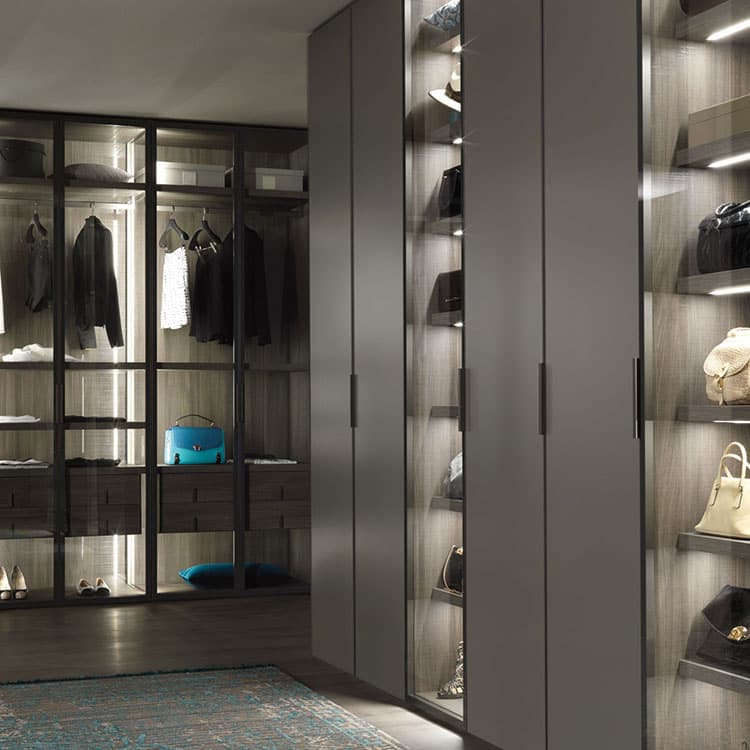Published Date: Jul 30, 2023
Written by: Zoona Sikander, Interior Design Writer & Social Media Content Creator
Edited by: Emma Cyrus, Senior Copy, Content & Editorial Writer
Reviewed by: Rey Amini, Senior Interior Designer & Architect
Fact-checked by: Benjamin Ibanez, Development & FF&E Manager
When embarking on a bedroom refurbishment that involves custom-built cabinetry, there are many factors to consider, one of which is: How deep do built-in wardrobes need to be?
While the size of a fitted wardrobe usually depends on the space you have available, the minimum depth required to ensure functional storage for your clothing is 60cm.
However, this can vary based on different factors so our expert team of joiners have put this guide together to help answer some frequently asked questions about built-in wardrobes and their benefits.

As a rule of thumb, the ideal depth for an ample-sized built-in wardrobe is approximately 67cm. Anything less than 60cm deep means you won't be able to make use of standard features like horizontal hanging rails.
As a wardrobe's intent is to keep your space well organised and clutter-free, it’s vital to establish a list of your requirements before you start the planning phase. This should include the number of drawers, hanging space and shelves needed to house all your clothes, accessories, jewellery, shoes and anything else you have in mind.
Once you have a clear picture of your requirements, you can enlist the help of a professional built-in wardrobe specialist to assist you with a detailed, functional layout.
Here are some useful measurements to ensure that you make the most of every inch of space in your closet.
Large wardrobes have hinged doors that are held in place by simple hinges and swing outwards when opened. Make sure you have enough space between the wardrobe and your other furniture to accommodate this.
The normal depth of this kind of wardrobe should be 60cm, but you can get away with a minimum of 55cm if you are not planning to hang any clothes.
The wardrobe's height should either equal the lintel level of the doors, which is typically 210cm, or you can make a full-height wardrobe by utilizing the space from floor to ceiling.
Each door should not be wider than 60cm or the hinges will be overloaded.
Wardrobes with sliding doors have panelled doors that slide from side to side on tracks, so are perfect if you have limited space and need to place your wardrobe close to your bed.
A sliding-door wardrobe should have a depth of 66cm plus a running track of about 5cm to allow unrestricted movement.
They should be at least 210cm long from left to right to accommodate two door panels of 105cm each. This will allow you to access one side at a time with ease.
Each panel should not be wider than 120cm or they will be too heavy to slide.


While commissioning a bespoke built-in wardrobe might seem daunting, there are certain advantages that make them 100% worthwhile. Here are 7 benefits you won’t regret:
Make the most of your built-in wardrobe (especially in cases when it's not too deep) by including the following features:


Before you install a built-in wardrobe, here are some key considerations:
Before you start planning your built-in wardrobe layout, it’s imperative to measure up. Here are some guidelines:
If you're unsure about how to take accurate measurements, contact our professional design team and let us do it for you.
The depth of a new built-in wardrobe depends very much on both your available space and specific storage needs.
Once you’ve decided where you would like to put it, our talented design team will facilitate every step of the process from layout to final installation. So if you can’t wait to get started, get in touch with us or book a one-on-one consultation with us today.
Get In Touch
Book A Video Chat
Book a video consultation and we'll advise you on furniture, space planning, colour schemes and much more.
Book A ConsultationVisit Our Showroom
Book a visit to our stunning, multi award-winning, 30,000 sqft.
Over 700 brands under 1 roof.








Most Popular on FCI London: Fitted Wardrobes | Luxury Designer Rugs | Luxury Sofas | Luxury Furniture Store | Luxury Interior Designers | Luxury Bedroom Furniture | Luxury Modern Chairs | Luxury Coffee Tables | Luxury Designer Kitchens | Luxury TV Units | Luxury Dining Tables | Luxury Storage Solutions | Luxury Sideboards | Luxury Stools & Bar Stools
Transparency's kind of our thing.
Here's what real customers have to say about us.
